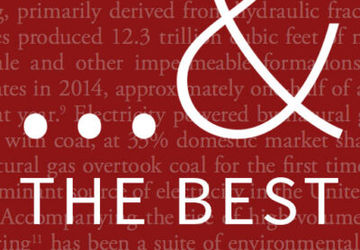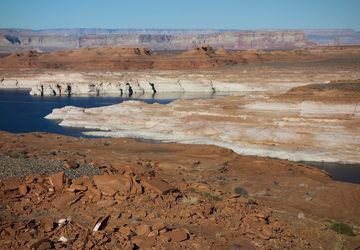In 2018, the Bill Lane Center sponosored a Sophomore College course on public lands. Students traveled to key public lands in Utah, where the above photo was taken at Lake Powell. This year, Professor Pat Shea is reprising the public lands course with different field visits, including a trip to the Santa Cruz Redwood Preserve and Jasper Ridge.
Bill Lane Center Visiting Scholar Pat Shea offers a winter quarter course on the complicated history of public lands in the United States
Recently I came across an op-ed in the Los Angeles Times in which the author made no effort to hide his outrage over the deforestation of Western public lands. The piece was by Christopher Ketchum, and I recognized his name immediately. Professor Pat Shea, a former director of the Bureau of Land Management and a biology professor at the University of Utah is currently teaching a public lands class for the Bill Lane Center. I’ve read Shea’s syllabus, and Christopher Ketchum’s new book, “This Land,” is a central text for the course. Shea chose Ketchum’s book because it offers a well-researched and detailed history of public lands in the United States, but it’s also a searingly harsh political critique of public land management. And in some ways, the anger that pulses through Ketchum’s book – anger at the environmental degradation, anger at the federal government for condoning it, anger at the cattle industry for sustaining itself on the destruction - is exactly the sentiment Pat Shea is trying to highlight in his course, for it underscores a prominent theme in nearly everything you might read or learn about public lands: that theme is conflict. As Shea notes, western public lands “have been the source of great opportunity, great scandals and almost constant dispute.”
Western public lands “have been the source of great opportunity, great scandals and almost constant dispute." -Pat Shea
While Ketchum’s diatribe has been criticized by High Country News and others as lacking nuance, reducing the complexity of the real-world dilemma land management agencies face when trying to appease both industry and conservationists, the urgency and ire in his writing mirror an ecological consciousness that is swelling in young people today. It also speaks to the relevance of the Lane Center’s educational programs, which aim to quench students’ thirst for actionable steps to preserve and protect the natural world, particularly as climate change grows more real and more threatening.
As a response to the budding ecological awareness of our students, some of whom grew up in the American West and spent childhoods immersed in the region’s pristine open spaces, the Lane Center offers classes like Shea’s public lands seminar and a climate resilience course focused on wildfires in California. Both classes reflect the center’s goal of providing academic and career pathways that allow students to work in service of safeguarding the planet. According to Shea, the Bill Lane Center is one of the best places on campus to launch students in this direction: “One theme that’s so important about the Lane Center,” he said, “it’s one of the most predictable and reliable portals for Stanford students to get into the real world. And while they are studying, the Lane Center is giving them opportunities to engage in service in the real world.”
Shea, who moved to Montana as a baby, and spent many of his own childhood summers enjoying nature and solitude in the Wind River wilderness areas of Wyoming, said that last year, at least eight of the students enrolled in his public lands class took jobs with not-for-profit organizations like the Nature Conservancy, or different ecosystem management groups. Much of their interest in this kind of work was sparked by talking with officials from different land management agencies during Shea’s course.
Getting students out of the classroom and into the field is equally important to Shea, who personally has found public lands to be a “touchstone for mental sanity,” offering opportunities to spend time in solitude with nature. “One of the things that Bruce Cain and the Lane Center do extraordinarily well is get students out of the classroom. We visit Santa Cruz, we go up to Jasper Ridge. In the digital world these students have grown up in, it’s important to take them outside the classroom and see that there are innumerable problems that are going to require their intellect, curiosity, creativity and skill.”
Protecting the public lands of the American West, and the nation’s natural resources as a whole, has always required the talent and dedication of young people. Pat Shea recalls that he was a student at Stanford in 1970 when Denis Hayes organized the very first Earth Day. When I was an undergraduate at Stanford from 1998-2002, I had a close friend pursuing a doctorate in environmental anthropology who went on to direct the climate policy efforts of one of the top five environmental think tanks in the world. But there was no Bill Lane Center when we were students, nor was there a Woods Institute for the Environment back then. Research centers focused on sustainability and ecosystem protection were nearly nonexistent, and there was very little disciplinary or interdisciplinary effort to address climate change in the late 1990s and early 2000s. But times have changed. Says Pat Shea, “I do think today’s students at Stanford, as opposed to in 2000 or 1970 – see an institutionalized highway they can travel on to address these crises. There are places they can go now for study and for work that have them gain experience in a scientific and sound policy way that allow them to study and solve aspects of climate change. This is where Lane Center and its Rural West Initiative are so important.”
Moving forward, the Bill Lane Center will certainly continue its efforts to provide students and alumni with meaningful opportunities – both in and out of the classroom – to learn about the incredible natural legacy we have in public lands. On March 19 in Nevada’s Carson Valley, Pat Shea will moderate a panel at the Bill Lane Center’s Eighth Annual Rural West Conference on rangeland fires, which pose a significant threat to both public lands and the American West in general. How do we protect these lands while also acknowledging the disparate goals of multiple constituencies such as the ranching, oil and gas, minerals and mining, and outdoor recreation industries? This is the kind of complex question Pat Shea and the Bill Lane Center for the American West are preparing the next generation of environmental stewards to answer, through their studies, careers, and in their everyday lives.




